AMD Ryzen 9 5980HS Cezanne Review: Ryzen 5000 Mobile Tested
by Dr. Ian Cutress on January 26, 2021 9:00 AM EST- Posted in
- CPUs
- AMD
- Vega
- Ryzen
- Zen 3
- Renoir
- Notebook
- Ryzen 9 5980HS
- Ryzen 5000 Mobile
- Cezanne
CPU Tests: Simulation
Simulation and Science have a lot of overlap in the benchmarking world, however for this distinction we’re separating into two segments mostly based on the utility of the resulting data. The benchmarks that fall under Science have a distinct use for the data they output – in our Simulation section, these act more like synthetics but at some level are still trying to simulate a given environment.
DigiCortex v1.35: link
DigiCortex is a pet project for the visualization of neuron and synapse activity in the brain. The software comes with a variety of benchmark modes, and we take the small benchmark which runs a 32k neuron/1.8B synapse simulation, similar to a small slug.
The results on the output are given as a fraction of whether the system can simulate in real-time, so anything above a value of one is suitable for real-time work. The benchmark offers a 'no firing synapse' mode, which in essence detects DRAM and bus speed, however we take the firing mode which adds CPU work with every firing.
The software originally shipped with a benchmark that recorded the first few cycles and output a result. So while fast multi-threaded processors this made the benchmark last less than a few seconds, slow dual-core processors could be running for almost an hour. There is also the issue of DigiCortex starting with a base neuron/synapse map in ‘off mode’, giving a high result in the first few cycles as none of the nodes are currently active. We found that the performance settles down into a steady state after a while (when the model is actively in use), so we asked the author to allow for a ‘warm-up’ phase and for the benchmark to be the average over a second sample time.
For our test, we give the benchmark 20000 cycles to warm up and then take the data over the next 10000 cycles seconds for the test – on a modern processor this takes 30 seconds and 150 seconds respectively. This is then repeated a minimum of 10 times, with the first three results rejected. Results are shown as a multiple of real-time calculation.
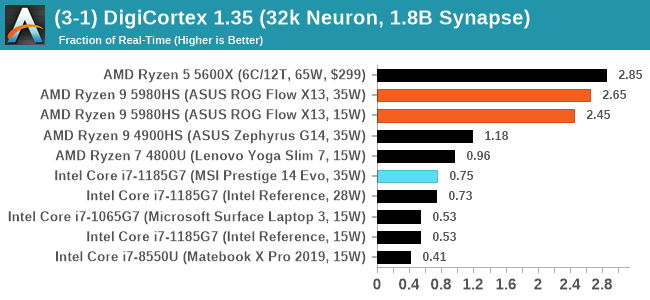
DigiCortex seems to have taken a shine to Zen 3, especially processors with a single chiplet of cores. Intel can't seem to compete here.
Dwarf Fortress 0.44.12: Link
Another long standing request for our benchmark suite has been Dwarf Fortress, a popular management/roguelike indie video game, first launched in 2006 and still being regularly updated today, aiming for a Steam launch sometime in the future.
Emulating the ASCII interfaces of old, this title is a rather complex beast, which can generate environments subject to millennia of rule, famous faces, peasants, and key historical figures and events. The further you get into the game, depending on the size of the world, the slower it becomes as it has to simulate more famous people, more world events, and the natural way that humanoid creatures take over an environment. Like some kind of virus.
For our test we’re using DFMark. DFMark is a benchmark built by vorsgren on the Bay12Forums that gives two different modes built on DFHack: world generation and embark. These tests can be configured, but range anywhere from 3 minutes to several hours. After analyzing the test, we ended up going for three different world generation sizes:
- Small, a 65x65 world with 250 years, 10 civilizations and 4 megabeasts
- Medium, a 127x127 world with 550 years, 10 civilizations and 4 megabeasts
- Large, a 257x257 world with 550 years, 40 civilizations and 10 megabeasts
DFMark outputs the time to run any given test, so this is what we use for the output. We loop the small test for as many times possible in 10 minutes, the medium test for as many times in 30 minutes, and the large test for as many times in an hour.
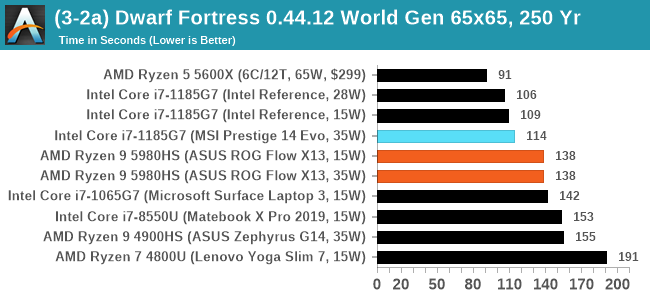
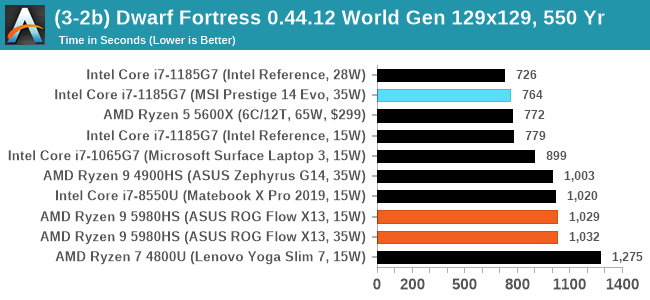
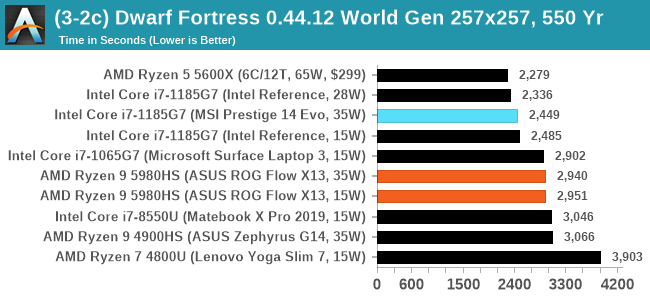
DF has historically been an Intel favorite, and we're not seeing much of a speedup for mobile Zen 3 over mobile Zen 2 here.
Dolphin v5.0 Emulation: Link
Many emulators are often bound by single thread CPU performance, and general reports tended to suggest that Haswell provided a significant boost to emulator performance. This benchmark runs a Wii program that ray traces a complex 3D scene inside the Dolphin Wii emulator. Performance on this benchmark is a good proxy of the speed of Dolphin CPU emulation, which is an intensive single core task using most aspects of a CPU. Results are given in seconds, where the Wii itself scores 1051 seconds.
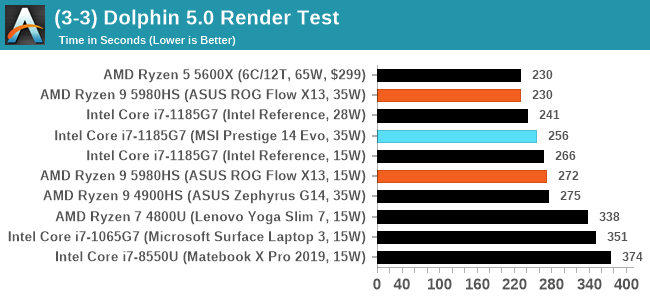
The 35W variant of Cezanne pushes through here, matching the desktop processor, and a sizeable performance jump over the previous generation Renoir.












218 Comments
View All Comments
Tams80 - Monday, February 1, 2021 - link
Yes.Max_Nexor - Tuesday, February 2, 2021 - link
Do you use the Handbrake presets unmodified? If so, have you considered turning off the de-interlacing filter?Filters can slow down transcoding speed dramatically. For example, using the same video and the 480p Discord preset, my system (i7-4790K) transcodes the video at 136 fps. Turning off the interlace detection and the filter results in a speed of 221 fps. Enabling the Denoise filter reduces transcode speed from 221 fps to 15 fps.
Would it not be a better to test just the transcoding speed, without any filters?
Farfolomew - Thursday, February 4, 2021 - link
I'd like to point out that this new Asus Flow X13 laptop is quite unique, and kinda/sorta the first of it's kind of any device out there. How do I mean?Well, up to now, it's been all but impossible to buy a 360-degree hinged TOUCHSCREEN device, that also has a 120hz refresh panel. The only other laptop that had this were ones from HP that had a first-generation Privacy Screen built-in. The privacy screen has a feature that you can turn on and off to enable the viewing angles to be severely limited when desired. The first-gen versions of these had a knock-on effect of running at 120hz, so the touchscreen, 360-degree foldable versions of those are the only other touchscreen laptops with high refresh panels. None of them had particularly great gaming performance, as the best one available was a 4-core Kaby Lake-R powered Ultrabook. The new versions of HP's Privacy Screen no longer run at 120hz, so it was a limited time option.
That's why I'm so excited about this ASUS laptop. I wish it didn't have an external GPU, and only relied on the iGPU instead. But this is as close to my perfect device that has yet been created.
Tams80 - Thursday, February 4, 2021 - link
You do realise that the external GPU dock is optional right? And that *all* models have an Nvidia GTX 1650 in the laptop itself?Farfolomew - Thursday, February 4, 2021 - link
AMD says it had "100 design wins" for Renoir, and 50% more, "150 design wins" for Cezanne. Whatever a "Design Win" means, for that matter.All I know is that when I go into Best Buy to peruse the laptops section, I consistently see two things:
1. While a substantially bigger section, with at least 10x as many different products on display, the "Windows" section is nearly always barren of customers, while the Apple section is most certainly dangerously close to violating every COVID Best Practices known to science.
2. Last I counted, there were about 20-30 Intel Tiger Lake "EVO" branded laptops from all the major OEMs, while I saw less than five, yes FIVE IN TOTAL Ryzen laptops even available for sale. And most of those Ryzen laptops were of the gaming variety. I don't recall seeing a single Ryzen Ultrabook (ie, with just a iGPU).
So I want to know, what is AMD's plans exactly for changing this? They may have an overall better product (albeit at times, only narrowly) than Intel's Tiger Lake, if they can't ship these and get them out in front of the normal Joe customer who doesn't follow the tech scene, they'll never gain significant market share from Intel in the Laptop segment.
GeoffreyA - Sunday, February 7, 2021 - link
I wonder how much of this is due to public perception. Enthusiasts know that AMD is good but most people don't know or care, while some have a vague instinct telling them Intel is first-rate and AMD substandard (corroborated by advice of salespeople in the shop). The laptop seems proper if it's got an Intel sticker, otherwise no good. And that's something which will be very hard for AMD to change. Perhaps fewer Ryzen gaming laptops will help. Even a new logo/sticker for their mobile CPUs, with minimal elegant design.GeoffreyA - Sunday, February 7, 2021 - link
Also, they need to capture the general public's imagination, as silly as that sounds. Just like Samsung did. There was a time when people didn't think much of Samsung (in my country at any rate) but nowadays go into the shop and they've got the best fridges, TVs, and washing machines. Or that's the perception.Farfolomew - Thursday, February 4, 2021 - link
I'm a bit disappointed and left scratching my head regarding the GPU review section of this article. 360p, 480p resolutions ... what are we playing MS-DOS games in EGA 256-color mode?!How did those games even run at such low resolutions? That's mind boggling.
At any rate, it all led to a confusing non-conclusion of what exactly the iGPU performance is on these Cezanne chips, and how it compares to Tiger Lake. Is it better than Tiger Lake or not? How much better than Renoir is it?
I realize this isn't all Ian's fault, as the laptop given to him has a 35W CPU, and we're asking him to compare it to 15W Ultrabooks, etc. But it was still very confusing to me. Hopefully it will become more clear when (and if) AMD Cezanne Ultrabooks come out with 15W parts.